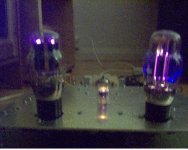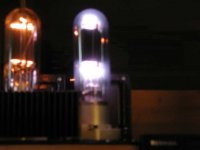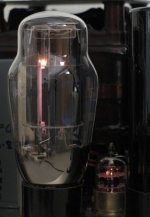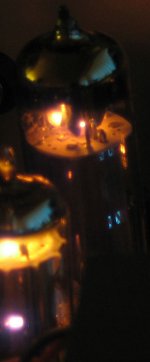Originally posted by: beamnet
How much blue glow is healthy in a penthode?
I can see a faint blue glow inside the anode. Grid shadow is very obvious.
Q#1: If it is a deep, deep blue and it seems to be fixed in position, i.e. not floating around, and appears to be on the inside surface of the glass envelope or the inside surface of the plate/anode, sometimes in discernable pattern or shape it is more than likely not gas but fluorescence. Crack open a brew and relax! 😀
This is caused by the high velocity electrons striking the glass or anode causing it to fluoresce. In the world of the very small those electrons are hitting with a great deal of force!
Q#2 Depending on the anode structure/shape like grid alignment slots or holes a pattern may be observed on the inner surface of the bulb. My EL34's and EL84's exhibit an "8" on the glass directly across from the grid alignment slots. Also the grid wires will cause alternating pattern on the inner surface of the anode. No blue 'glow' were it is shadowed by the grid wires.
So this kind of blue glow really has no relevance as to the quality of vacuum as it is not caused by gas. I have used/bought dozens of new EL34's etc and I do not recall any 'not' having this blue glow to some extent. Interestingly as the tube ages this so-called blue glow fades.
As stated in earlier posts by others in this thread if the blue glow appears in-between elements, this may well be gas! People have differing opinions as to colour. Deep blue is generally not gas, whereas purple, pink, or fuchsia is probably gas! Even a bluish glow that floats may be gas as well.
then i had some very old 7027a, these had dancing blue glow which travelled around the glass, even reacting to bass!! =gass
Definitely GAS!
Now I've seen the intensity of the blue "8" on the surface of the bulb and the inner surface of the plate vary ( not floating, moving around!) to the music. This is to be expected, alternating (not AC!), changing amount of electrons flying from the cathode on their way to the plate!
Cheers everyone! And enjoy your music!
Wayne 😉
Edit: Some will say the "fading" is caused by the getter working to remove the GAS... I disagree because the glow was not caused by gas in the first place.
Wow! Now that is seriously gassy. This really does raise the question of "how much glow?" The typical glow inside an EL84 is really quite small and quite faint. I have a 6AS7G with a little blue glow near the glass and it was great fun (well, for a minute or two) pulling it around with a magnet, but I couldn't get it to show up well on a photograph. Perhaps the criterion should be that if you can't photograph it, don't worry about it.
I could photograph the glow from my 6AS7G, the right one in the pic. And this with a low quality digicam. Do you think this is OK😉
Attachments
Wow! Now that is seriously gassy.
I should have known better when I bought 2 vintage VT4-C tubes at a hamfest for $5. I put them in my amp and turned it on. The attached picture was what it looked like in the amp. It is fuzzy because I was in panic mode when I took the picture. The extreme tube current blew out the mosfet driver and fried the 10 ohm cathode resistor.
The picture in the previous post was taken with the offending tube connected to a power supply. The color and intensity of the glow could be controlled by adjusting the tube current and voltage. That picture was at 550 volts and 250 mA, the max from this power supply. At lower power the color was deep blue.
Most of the 6AS7 glow in the previous post appears to be on the glass itself. This is usually OK.
Attachments
what i was referring to, is a glow INSIDE the structure
you can see the grid and inside of the anode though holes in the anode. You see "shelves" of blue glow betgween grid and anode, the electron beams. The are a faint blue.
Bas
you can see the grid and inside of the anode though holes in the anode. You see "shelves" of blue glow betgween grid and anode, the electron beams. The are a faint blue.
Bas
p_ete2003,
That pink color is a giveaway... and alot of glow... bet that tube on the right is too gassy.
🙁
That pink color is a giveaway... and alot of glow... bet that tube on the right is too gassy.
🙁
Yes, beamnet.....
That is exactly what i was describing about the JJ7027A and the svetlana 6l6GC, You actually see the 'electron beams'
So, you look inside the tube through the hole in the vertical side of the anode....
You have to peek through the hole in an angle(to look around the cathode to see the blue 'vertical stripe', in this blue vertical stripe you see horizontal stripes which are a bit less blue(or less glowing, whatever)
As i have been told this glow inside the structure is a sign of a good tube.
The glow never changes...and it looks solid rather than floating against the inside of the anode....
and the fact that both new tubes (JJ) as 'old' tubes (Svetlana) have exactly the same although, the JJ had it a tad brighter (horizontal stripes were more defined)
so i think: don't Worry.....
That is exactly what i was describing about the JJ7027A and the svetlana 6l6GC, You actually see the 'electron beams'
So, you look inside the tube through the hole in the vertical side of the anode....
You have to peek through the hole in an angle(to look around the cathode to see the blue 'vertical stripe', in this blue vertical stripe you see horizontal stripes which are a bit less blue(or less glowing, whatever)
As i have been told this glow inside the structure is a sign of a good tube.
The glow never changes...and it looks solid rather than floating against the inside of the anode....
and the fact that both new tubes (JJ) as 'old' tubes (Svetlana) have exactly the same although, the JJ had it a tad brighter (horizontal stripes were more defined)
so i think: don't Worry.....
Believe me, i am NOT worried. I have tons of these tubes, and so far they haven't showed any sign of deterioration. The still pump those electrons through my speakers like an hydraulic piston😉 boomboom!
That pink color is a giveaway... and alot of glow... bet that tube on the right is too gassy.
This amp is in it's prototype phase. I have another 6AS7G but haven't tested it with this amp yet. The schema is Lilliput from Audiokit. Only thing I've changed is the psu. The left tube is a 5U4 rect. I have used this amp for a couple of months and there hasn't been any problems.. I think I'll keep the things as they are and start building the chassis.
Pink glow is bad... umkay. Tubes with pink glow are bad... umkay. If you have pink tubes, you're bad... umkay...
There are two kinds of blue glow you get from VTs. With NOS 807s (United and RCA) I get the sky blue glow that forms patterns corresponding to the mechanical structure behind it. This is due to cobalt contamination of the glass. The cobalt ions give off their characteristic spectral color when excited by stray electrons. You can even see it sometimes on the metallic parts if these also have cobalt. It's pretty harmless, and looks cool. It's NBD. Three out of four 807s in my amp glow like that.
Gas contamination is frequently a deeper purple if not too severe. It becomes a more blue/pink as the gas pressure goes up. You can tell the difference since flourescing cobalt glow does not respond to a touch. Gas glow will react to a touch much like a plasma sphere. The glow may intensify under your finger, or might break up into a spider web-like pattern, or it may even dissappear completely. It will also follow your finger as you move it along the outside. You see that, then it's time to think about replacing even if the amp seems to be working just fine. It won't be that way for long!
The only exception is putting NOS tubes into service for the first time. These may go a bit gassy sitting cold on a backroom shelf for a half century. Most getters don't work cold, and these have been outgassing for decades. This type of gas glow will dissappear soon after you heat 'em up and the getter starts working. Just keep an eye on them to be sure that it doesn't return, as that probably means a slow leak.
Gas contamination is frequently a deeper purple if not too severe. It becomes a more blue/pink as the gas pressure goes up. You can tell the difference since flourescing cobalt glow does not respond to a touch. Gas glow will react to a touch much like a plasma sphere. The glow may intensify under your finger, or might break up into a spider web-like pattern, or it may even dissappear completely. It will also follow your finger as you move it along the outside. You see that, then it's time to think about replacing even if the amp seems to be working just fine. It won't be that way for long!
The only exception is putting NOS tubes into service for the first time. These may go a bit gassy sitting cold on a backroom shelf for a half century. Most getters don't work cold, and these have been outgassing for decades. This type of gas glow will dissappear soon after you heat 'em up and the getter starts working. Just keep an eye on them to be sure that it doesn't return, as that probably means a slow leak.
Hi Miles,
Isn´t it just the fluorite (sic) contents in the glas?
Anyway, I have noticed that shadow pattern play especially with 807s (Zaerix relabeled GE, Siemens QE06/50, but also russian ones), too, even at moderate plate voltages. Dunno why so often present with 807s ...
Tom
With NOS 807s (United and RCA) I get the sky blue glow that forms patterns corresponding to the mechanical structure behind it. This is due to cobalt contamination of the glass.
Isn´t it just the fluorite (sic) contents in the glas?
Anyway, I have noticed that shadow pattern play especially with 807s (Zaerix relabeled GE, Siemens QE06/50, but also russian ones), too, even at moderate plate voltages. Dunno why so often present with 807s ...
Tom
Tubes4e4 said:Hi Miles,
Isn´t it just the fluorite (sic) contents in the glas?
Not flourine, definitely cobalt.
Anyway, I have noticed that shadow pattern play especially with 807s (Zaerix relabeled GE, Siemens QE06/50, but also russian ones), too, even at moderate plate voltages. Dunno why so often present with 807s ...
Tom
Ya got me there. The United 807s were NOS from England made sometime during the 1950s. Don't know about the RCAs since I picked these up at a hamfest. Both United and one RCA show that blue glow. One RCA does not. The one RCA glows much brighter than either United, which can only be seen with the lights off. None of the other tubes in that amp glow. Of course, none of them operate at the same voltages that the 807s do.
I also have a few 6AS7G that have the blue glow on the inside of the glass. My experience so far is that the tubes with the glow are noisy, but I don't have a large enough sample of the tubes to make a definite conclusion.
Miles Prower said:
The United 807s were NOS from England made sometime during the 1950s.
Ah....at that time most of these were originally KenRads (US/Can) rebranded imports.
Some 25 yrs ago I bought hundreds and not one has failed and sofar all glowed consistent blue and are well-known for this. On warm up the blue neon glow is strongest within the tube structure.
Look at the tubes in the dark with averted vision. One sees far more. One will even detect smaller tubes doing this as well. Even the 7199's glow blue.
richj
- Status
- Not open for further replies.
- Home
- Amplifiers
- Tubes / Valves
- Blue glow confused :(



